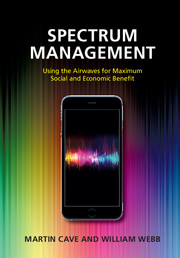Book contents
- Frontmatter
- Contents
- Preface
- Acknowledgments
- Plan of the book
- List of abbreviations
- Part I Fundamentals
- 1 Spectrum management around the world
- 2 The technical challenge
- 3 The economic challenge: a basic primer on spectrum economics
- Part II Economic management of spectrum
- Part III Sharing and other emerging approaches to spectrum management
- Part IV Case studies and conclusions
- About the authors
- Index
- References
1 - Spectrum management around the world
from Part I - Fundamentals
Published online by Cambridge University Press: 05 November 2015
- Frontmatter
- Contents
- Preface
- Acknowledgments
- Plan of the book
- List of abbreviations
- Part I Fundamentals
- 1 Spectrum management around the world
- 2 The technical challenge
- 3 The economic challenge: a basic primer on spectrum economics
- Part II Economic management of spectrum
- Part III Sharing and other emerging approaches to spectrum management
- Part IV Case studies and conclusions
- About the authors
- Index
- References
Summary
The uses of radio spectrum
Introduction
The use of radio spectrum is at the heart of almost all aspects of daily personal, business and government activities. Life without the services reliant upon spectrum would be unthinkable – either no or very limited TV, radio, Internet, air travel, mobile phones, and much, much more. In this section, we provide an overview of the key uses of radio spectrum, their current allocations, and their likely future needs. As an illustration, Figure 1-1 shows the key uses of the spectrum in the UK and their current split of allocations across broad frequency bands.
In interpreting the figure (and recalling that it refers only to the UK) it is, first, worth noting that the usage of all frequency bands will add to greater than 100%. This is because much of the band is shared, and in the chart, if two applications both shared, say, 10% of the band, both would be considered to be using this 10% since it is typically very hard to divide up shared utilization. On this basis, some uses appear overstated: for example, program making and special equipment (PMSE), which is broadly the use of wireless microphones and cameras, appears to have more access to spectrum below 1 GHz than mobile telecommunications, but all the PMSE allocation is shared with broadcasting and PMSE needs to work around broadcasting, giving it little “real” allocation in practice.
In the figure the use is split into four different frequency bands. The advantages and disadvantages of different frequencies are discussed in more detail in the next chapter. Suffice it to say here that the bands below 6 GHz are considered much more valuable than those above and that the band below 1 GHz is especially useful where long-range propagation is required. We now turn to each of the sectors to provide a brief overview.
The public sector
The public sector encompasses all governmental (local, regional, and national) use, which is very varied.
- Type
- Chapter
- Information
- Spectrum ManagementUsing the Airwaves for Maximum Social and Economic Benefit, pp. 3 - 23Publisher: Cambridge University PressPrint publication year: 2015



